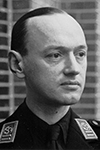Former NCRV Studio Hilversum
This building was constructed between 1938 and 1941 and opened in 1940.
Architecture
Built in the Dudok style by architect J.H. van der Veen, it includes a bicycle shed. A stained-glass triptych (1940) by Max Nauta adorns the hall. Originally, the building comprised one large and five small studios surrounding a central announcer's booth, visible as a tall tower. An underground passage led to Villa Henriëtte, which served as an office. The complex is situated on sloping grounds, with a rectangular pond in front of the south facade and a terrace near the central projection. After the war, there were three major expansions:
- 1956: technical wing at the rear
- 1958: office wing, followed by two additional wings (architect J. van der Zee)
- 1982-1988: integration into a new building by architect Jan Verster.
History of the building during the German occupation:
During the German occupation, the Dutch Broadcasting Corporation (Nederlandsche Omroep) was located here. The Germans narcoticized the broadcasting company, and it was subsequently used for (war) propaganda. Broadcasts were broadcast from here under the supervision of the Department of Public Information and the Arts, led by NSB member Willem Herweijer. The location remained active until just before the liberation in May 1945.
The complex is a national monument.
Do you have more information about this location? Inform us!
Source
- Text: TracesofWar
- Photos: TracesofWar
Nearby
Museum
Point of interest
- Villa Henriëtte - Hilversum
- Office Germanic SS Radio Department - Hilversum
- NSB Office Hilversum - Hilversum
Monument
- Memorial Resistance Hilversum - Hilversum
- Memorial Jewish Cemetery Hilversum - Hilversum
- Memorial "The New Lyceum" Old Cemetery "Remember to die" Hilversum - Hilversum
Cemetery
- Dutch War Graves Municipal Cemetery Hilversum - Hilversum
- Dutch War Grave Roman Catholic Cemetery Hilversum - Hilversum
- Dutch War Graves Noorderbegraafplaats Hilversum - Hilversum
Remembrance Stone
- Stumbling Stones Schuttersweg 24 - Hilversum
- Stumbling Stone Gijsbrecht van Amstelstraat 488 - Hilversum
- Stumbling Stone Vossenstraat 63 - Hilversum
Fortification
- German Bunker & House Catharina van Renneslaan 5 - Hilversum
- Blaskowitzbunker Hilversum - Hilversum
- Group Shelter Type 1918/I De Fransche Kamp - Bussum






